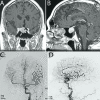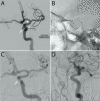Management of Coincident Pituitary Macroadenoma and Cavernous Carotid Aneurysm: A Systematic Literature Review
- PMID: 34603930
- PMCID: PMC8481005
- DOI: 10.1055/s-0041-1735904
Management of Coincident Pituitary Macroadenoma and Cavernous Carotid Aneurysm: A Systematic Literature Review
Abstract
Introduction Pituitary adenomas are a common intracranial pathology with an incidence of 15 to 20% in the population while cerebral aneurysms are less common with a prevalence of 1:50 patients. The incidence of aneurysms in patients with pituitary adenoma has been estimated at 2.3 to 5.4% of patients; however, this remains unclear. Equally, the management of concomitant lesions lacks significant understanding. Methods A case report is presented of a concomitant cerebral aneurysm and pituitary adenoma managed by minimally invasive endovascular and endoscopic methods, respectively. A systematic review of the literature for terms "pituitary adenoma" and "aneurysm" yielded 494 studies that were narrowed to 19 relevant articles. Results We report a case of a 67-year-old patient with an enlarging pituitary macroadenoma, cavernous carotid aneurysm, and unilateral carotid occlusion. After successful treatment of the aneurysm by a pipeline flow diverter, the pituitary adenoma was surgically resected by an endoscopic transsphenoidal approach. Conclusion The use of a pipeline flow diverter and endonasal approach was feasible in the treatment of our patient. This is the first report to our knowledge of the use of pipeline flow diversion in the management of a cavernous carotid aneurysm prior to pituitary adenoma treatment.
Keywords: cavernous carotid aneurysm; endoscopic; intracranial aneurysm; macroadenoma; pipeline; pituitary adenoma; transphenoidal.
The Author(s). This is an open access article published by Thieme under the terms of the Creative Commons Attribution-NonDerivative-NonCommercial License, permitting copying and reproduction so long as the original work is given appropriate credit. Contents may not be used for commercial purposes, or adapted, remixed, transformed or built upon. ( https://creativecommons.org/licenses/by-nc-nd/4.0/ ).
Conflict of interest statement
Conflict of Interest None declared.
Figures



Similar articles
-
Staged endovascular treatment of a coexisting parasellar aneurysm and endoscopic resection of a pituitary macroadenoma: illustrative case.J Neurosurg Case Lessons. 2022 Mar 7;3(10):CASE21699. doi: 10.3171/CASE21699. Print 2022 Mar 7. J Neurosurg Case Lessons. 2022. PMID: 36130536 Free PMC article.
-
Expanded endonasal endoscopic approach for resection of a growth hormone-secreting pituitary macroadenoma coexistent with a cavernous carotid artery aneurysm.J Clin Neurosci. 2012 Oct;19(10):1437-41. doi: 10.1016/j.jocn.2011.11.032. Epub 2012 Jul 25. J Clin Neurosci. 2012. PMID: 22836036
-
Endovascular management of internal carotid artery injuries secondary to endonasal surgery: case series and review of the literature.J Neurosurg. 2016 Nov;125(5):1256-1276. doi: 10.3171/2015.6.JNS142483. Epub 2016 Jan 15. J Neurosurg. 2016. PMID: 26771847 Review.
-
Intrasellar aneurysm and a growth hormone-secreting pituitary macroadenoma. Case report.J Neurosurg. 2004 Mar;100(3):557-9. doi: 10.3171/jns.2004.100.3.0557. J Neurosurg. 2004. PMID: 15035295
-
Endoscopic Endonasal Surgery for Remission of Cushing Disease Caused by Ectopic Intracavernous Macroadenoma: Case Report and Literature Review.World Neurosurg. 2017 Feb;98:870.e5-870.e10. doi: 10.1016/j.wneu.2016.12.021. Epub 2016 Dec 18. World Neurosurg. 2017. PMID: 28003168 Review.
Cited by
-
Management principles of cranial base tumor with aneurysm.Neurosurg Rev. 2023 Jan 3;46(1):31. doi: 10.1007/s10143-022-01936-8. Neurosurg Rev. 2023. PMID: 36595070
-
Giant Prolactinoma Embedded by Pseudoaneurysm of the Cavernous Carotid Artery Treated with a Tailored Therapeutic Scheme.J Neurosci Rural Pract. 2022 Jul 4;13(3):358-369. doi: 10.1055/s-0042-1749662. eCollection 2022 Jul. J Neurosci Rural Pract. 2022. PMID: 35945997 Free PMC article. Review.
-
Double jeopardy - pituitary apoplexy complicated by ruptured aneurysm of the internal carotid artery within an adenoma: a case report.BMC Neurol. 2022 Dec 9;22(1):463. doi: 10.1186/s12883-022-02999-2. BMC Neurol. 2022. PMID: 36494782 Free PMC article.
-
Simultaneous resection of pituitary adenoma and clipping of aneurysm through endoscopic endonasal approach: a case report.Front Oncol. 2024 May 24;14:1341688. doi: 10.3389/fonc.2024.1341688. eCollection 2024. Front Oncol. 2024. PMID: 38854715 Free PMC article.
References
-
- Ezzat S, Asa S L, Couldwell W T. The prevalence of pituitary adenomas: a systematic review. Cancer. 2004;101(03):613–619. - PubMed
-
- Aghi M K, Chen C C, Fleseriu M. Congress of neurological surgeons systematic review and evidence-based guidelines on the management of patients with nonfunctioning pituitary adenomas: executive summary. Neurosurgery. 2016;79(04):521–523. - PubMed
-
- French Endocrinology Society non-functioning pituitary adenoma work-group . Chanson P, Raverot G, Castinetti F, Cortet-Rudelli C, Galland F, Salenave S. Management of clinically non-functioning pituitary adenoma. Ann Endocrinol (Paris) 2015;76(03):239–247. - PubMed
-
- Seinfeld J, Karim S. StatPearls Publishing; Treasure Island, FL: 2020. Cavernous sinus aneurysm. - PubMed

